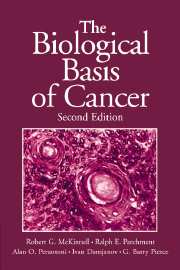Book contents
- Frontmatter
- Contents
- Preface
- Introduction: Letters illustrating clinical aspects of cancer
- 1 The pathology of cancer
- 2 Invasion and metastasis
- 3 Carcinogenesis
- 4 Genetics and heredity
- 5 Cancer-associated genes
- 6 Cancer in nonhuman organisms
- 7 Epidemiology
- 8 Lifestyle: Is there anything more important?
- 9 The stem cell basis of cancer treatment: concepts and clinical outcomes
- 10 Oncology: The difficult task of eradicating caricatures of normal tissue renewal in the human patient
- Appendix: Description of selected tumors
- Glossary
- References
- Index
- Plate section
- References
References
Published online by Cambridge University Press: 05 June 2012
- Frontmatter
- Contents
- Preface
- Introduction: Letters illustrating clinical aspects of cancer
- 1 The pathology of cancer
- 2 Invasion and metastasis
- 3 Carcinogenesis
- 4 Genetics and heredity
- 5 Cancer-associated genes
- 6 Cancer in nonhuman organisms
- 7 Epidemiology
- 8 Lifestyle: Is there anything more important?
- 9 The stem cell basis of cancer treatment: concepts and clinical outcomes
- 10 Oncology: The difficult task of eradicating caricatures of normal tissue renewal in the human patient
- Appendix: Description of selected tumors
- Glossary
- References
- Index
- Plate section
- References
- Type
- Chapter
- Information
- The Biological Basis of Cancer , pp. 401 - 468Publisher: Cambridge University PressPrint publication year: 2006

